The Google Nexus 5X Review
by Brandon Chester on November 9, 2015 8:00 AM EST- Posted in
- Smartphones
- LG
- Mobile
- Android 6.0
- Nexus 5X
Display
A smartphone's display is unquestionably one of its most important aspects, and failing to deliver a good display can be a fatal flaw for a device. If the screen doesn't have sufficiently high brightness and contrast then its usability with high ambient lighting will be severely crippled. Inaccurate color rendition will cause photos and videos that are taken and viewed on the device to look radically different from other devices. Pushing a wide color gamut can also have ramifications that go beyond making the display inaccurate, such as reducing battery life on AMOLED devices by having to drive a higher voltage in order to achieve the wider gamut.
Last year's Nexus 6 ended up being a significant disappointment as far as the display was concerned. It was immediately obvious to me that the gamut was far too large, and that peak brightness was too low. My testing confirmed both of these things, and I was disappointed mainly because the Nexus 5 from the previous year sold for significantly less than the Nexus 6, and sported imperfect but relatively good display calibration. While this year's Nexus 6P is an AMOLED display that we are yet to test, the Nexus 5X sports an IPS LCD like its predecessor. At 5.2", this year the display is a bit bigger than the 4.95" Nexus 5, but it's still a far cry from the 5.96" display that was on the Nexus 6.
To analyze the quality of the Nexus 5's display I've run it through our standard display testing suite. As always, displays are calibrated to 200nits of brightness, and results are measured with an i1Pro 2 spectrophotometer, and managed using SpectraCal's CalMAN 5 software. Contrast measurements are done with an i1Display Pro colorimeter due to the i1Pro 2's more limited accuracy with very low brightness levels.
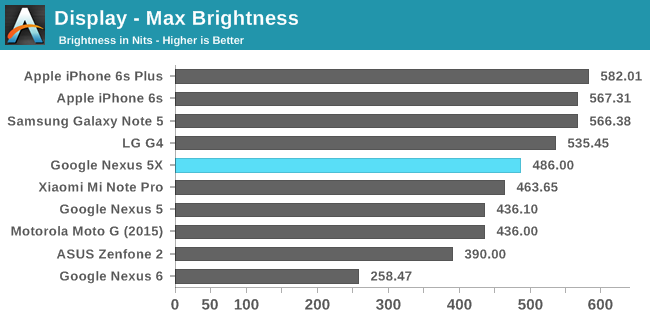

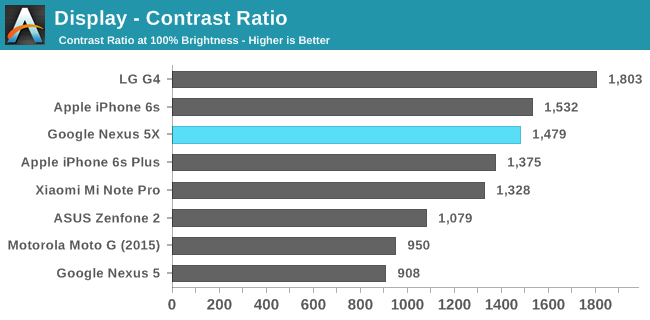
The most basic data point to examine when moving beyond resolution is a display's maximum brightness and its contrast ratio. The Nexus 5X does very well here, with a peak brightness of 486 nits, and a minimum black level of 0.32 nits, which leads to a contrast ratio of 1479:1. This is the result of the use of photo-alignment to influence subpixel orientations and reduce light leakage, which results in deeper blacks and thus a higher contrast ratio. While many other LCD-based smartphones are also using this technology, to see it applied to a $379 smartphone is very exciting. The display's maximum brightness is also a healthy improvement over the Nexus 5, and I haven't run into any situations where the display can't get bright enough to counter glare from the cover glass.
Something that doesn't really show up in any of our figures is the visibility of the display's capacitive sensors. On the Nexus 5 these were fairly noticeable when there was any light shining on the display, and this is unchanged on the Nexus 5X. This is something that can be observed on every device with capacitive touch, although on AMOLED devices and iPhones it's extremely hard to see. I only felt it was worth pointing out because it does seem more pronounced on the Nexus 5X than some of the other devices I have.
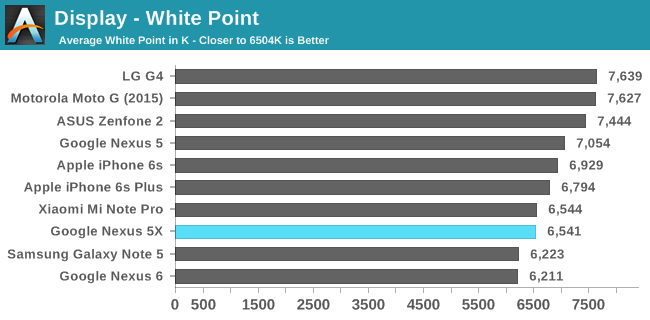
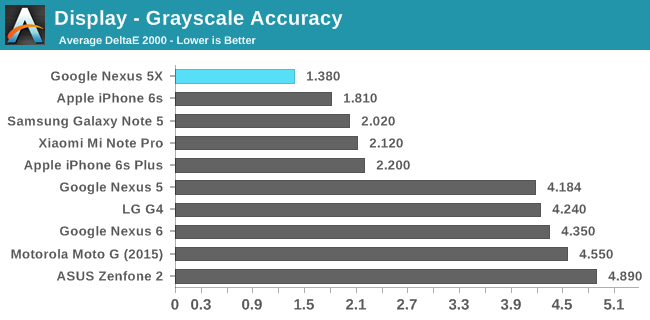
Greyscale accuracy on the Nexus 5 is impeccable. Gamma does tend slightly upward as one moves past the 20% mark, but it's still quite accurate and most greyscale errors are approaching the point where the human eye could not even distinguish them from their reference colors when placed side by side. The RGB component balance for each shade of grey is also very good, and the display's average white point is only ever so slightly above the targeted 6504K. There's not much more to say, as this level of calibration is exceptional for a device of this price. The Nexus 5 certainly had fairly good calibration, but issues with the gamma made the display appear washed out which was a common complaint, and the Nexus 5X resolves that while also boosting accuracy significantly.
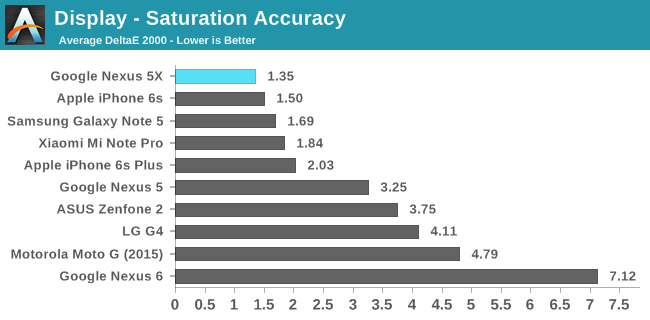
The accuracy for 20% saturation steps on the Nexus 5X is also incredibly high. It's actually the lowest DeltaE on record for a smartphone - lower than even the Galaxy Note5 and iPhone 6s - and there's honestly nothing at all that I could criticize about the rendition of primary and secondary colors on the display. The chart above also shows how much improvement has been made compared to the Nexus 5 and Nexus 6, with the latter being especially bad due to its overly wide gamut.
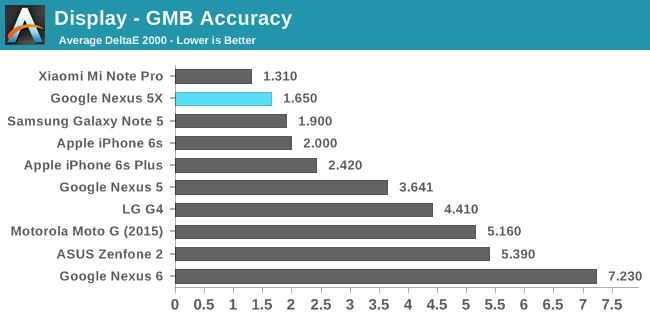
Once again the Nexus 5X provides an incredibly high level of accuracy, with color mixtures being reproduced almost as accurately as primary and secondary colors. It's not the absolute best result on record due to the Mi Note Pro's even higher level of accuracy, but you would only be able to tell that the rendition is wrong if you had the color right beside the reference color with absolutely no motion occurring, and that's well beyond the level of accuracy that is really necessary for a mobile device.
I really don't know what else to say about the Nexus 5X's display, because there's really nothing that can be criticized. I would certainly like if the brightness went up to 600 nits, but I would also prefer that it went to 6000 nits, and obviously that's asking a bit much. As far as LCDs go, the Nexus 5X has one of the best, if not the best that I've seen to date. At this point Google and their OEM partners are going to have to look to gamut as a vector of improvement, but only after proper color management is available at the OS level in order to avoid the problems that have plagued wider gamut displays, which have lacked suitable color management to properly map sRGB content into the wider color space.


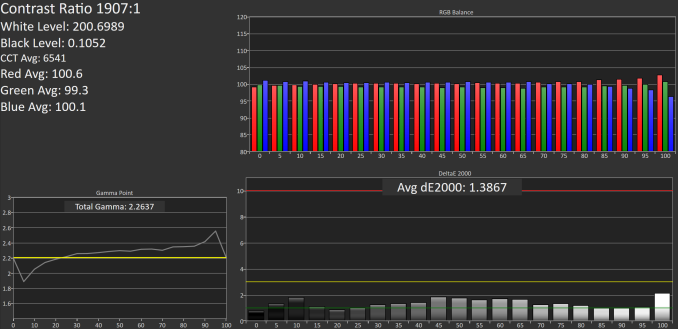
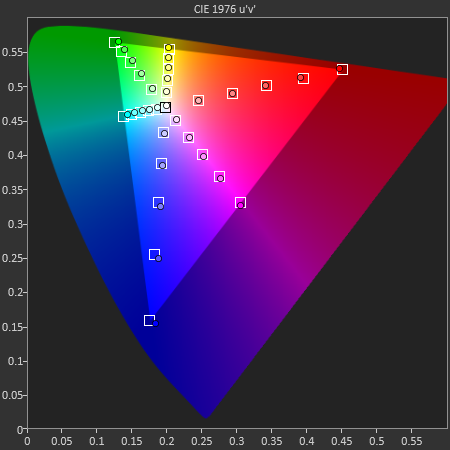









197 Comments
View All Comments
Brandon Chester - Sunday, November 15, 2015 - link
There are additional sentences in that paragraph.Klug4Pres - Monday, November 16, 2015 - link
True, but the main issue is that it is using "3 of its 4 cores most of the time", so these are the exact same cores that oscillate between 1 GHz and 1.6 GHz, yet you refer to them as "the other three". You are seeking to imply that the idle fourth core is what is "other" relative to the active three, but since you have not explicitly introduced the idle fourth core in what you have written, this does not work and just confuses the reader.As for "the key points", unless you manage to refer to them all in this one introductory sentence, it would be better to split the paragraph up, e.g. you can say "There are [n] key points to get from the graphs. Firstly, ... Secondly, ... etc., or you could say "There are a few key points to get from the graphs. With the Snapdragon 800 in the Nexus 5, we see that only 3 of its 4 cores are used most of the time, .... etc
Aritra Ghatak - Saturday, November 21, 2015 - link
@Brandon Chester the CPU throttle plot that you explained for Nexus 5X is it what you would expect from the LG G4 too? I checked LG G4's review although there was no CPU clock frequency v/s time plot there for the G4, but from what I understood it actually manages to give pretty good sustained CPU performance. How is this possible? Could you please explain?bw13121 - Sunday, November 22, 2015 - link
Ill second that, If there is a noticeable difference in sustained CPU Performance between G4 & N5X, why is this? Cheaper heatsink/cooling assembly? It would be good for an expert to answer this, then again that's probably the reviewer..:)Matsod - Monday, November 23, 2015 - link
Its a good screen, no doubt. Expect when scrolling, text gets really blurry. Compared side by side with the Nexus 5 its a noticeable difference. Please test, especially if you own both devices, and respond.Jojo99 - Monday, December 21, 2015 - link
I have a 32GB 5X running 6.0.1. I do not notice that problem.DukeOfAnandTech - Sunday, November 29, 2015 - link
I loved the previous article showing several test of the headphone output of the phones. Will measurements of this phone be added to that article in the near future? Also, will we be seeing the reviews add a page dedicated to audio output quality at some point?blzd - Monday, November 30, 2015 - link
Wasn't there a graph showing sustained GPU performance? Was that removed?Derek712 - Thursday, December 3, 2015 - link
Hi Brandon,Do you actually calibrate the display before you test or do you test it right out of the box? My colors are pretty warm out of the box and many online complain about yellowish colors right from the get go. Some have gotten replacement units with cooler whites. I'm wondering if there's anything I can do to correct it other than RMA.
Chris2fer - Friday, December 4, 2015 - link
The 5 was AWESOME. The 5x is awful. I am wondering if reviewers actually spend time with these devices. I will say the camera is decent and the fingerprint readers is great but the phone's performance is actually worse than the 5. My 5x is so laggy its painful to use. About every other day it locks up completely and doesn't respond for about 5min until it reboots.STAY AWAY FROM THIS THING!